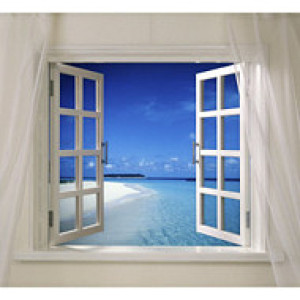The Brick, Works
Moving on from yesterday, my next blip is also to do with Quarr Abbey too. This is the Sanctuary, the simple alter with the Crucifix beside it, lifted high above all those presiding, but in clear view of everyone who is seated in the church. Hanging over the alter is the pyx, which is hung over it as a tabernacle, where the Blessed Sacrament is kept.
In many respects it is not the furnishing that is important in this place, but the crafted and creative use of the bricks that were imported from Zandvoorde in Belgium. These Flemish bricks, all 1,984,250, cost a princely sum of £3,767.11s.11.5d in 1911. Dom Paul Bellot wanted the visitor’s eye to be deliberately lead into the church by the subtle use of coloured bricks, as you walk in, the bricks becomes richer in colour and as you gaze upon the Sanctuary so the light becomes more natural. There is a real sense of space here. It is not so much the hight of the ceiling rafters, or the majestic brick laying skills of the three hundred labours who build this place so quickly, but it is the detail within the walls. Some of the detail is really so small that you could be forgiven for not noticing it.
Behind the Sanctuary there is some clever use of brink laying that is all to often not used these days, or rather not designed to be built as a visual aid to the building, or rooms within. Here we fine a number of simple Celtic crosses found within the eight little alcoves behind the alter. There are also three candle arms built into the wall, just as there is along each wall of the church. Above the arm is a patterned brick square with what looks like four red circles on a white background. On closer inspection these red circles are not round, but almost square in nature with an additional two sided nick built into and yet have a diagonal cut on opposite corners, making this shape irregular, on closer inspection.
Concrete has been used in places where it is need at the top of pillars, but in the main concrete, while at the time still a new building material, was not widely used. However, it is a nice touch. The richness of the red brick next to the light bricks, helps gives the illusion of depth, where the depth, might only be one brick deep and not more.
With the brick work not being laid in just one direction, but laid in multiply directions and shapes this very find building gives the structure a lot of strength of character. They have been used in a bold, innovated way. As you look along the walls or look up at the building you cannot help, but be lead heavenwards, thus lifting our own spirit to heaven. The Great Tower that is supported by all of these supporting arches, more akin to an Islamic Mosque in design, rather than a Christian Church, has stood the test of time, albeit for a little over a hundred years.
When Dom Paul Bellot came back to Quarr Abbey for a visit he stood for a long time gazing up at the Great Tower and pronounced that the Abbey was his finest piece of work. How many of us can say the same about what we produce in the same way...

Comments
Sign in or get an account to comment.


